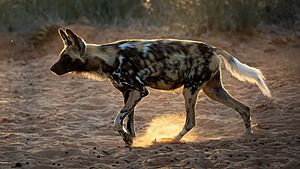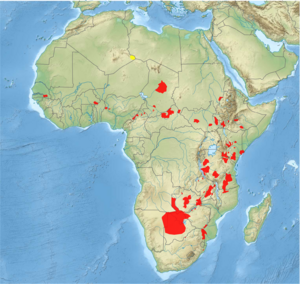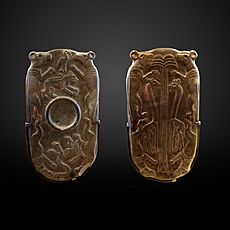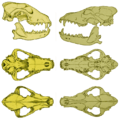African wild dog facts for kids
Quick facts for kids African wild dogTemporal range: Middle Pleistocene – present (200,000–0 years BP)
|
|
|---|---|
 |
|
| African wild dog in South Africa | |
| Conservation status | |
| Scientific classification | |
| Genus: |
Lycaon
|
| Species: |
pictus
|
 |
|
| African wild dog range according to the IUCN Red List
Extant (resident) Probably extant (resident) |
|
The African wild dog, also sometimes called the painted dog or Cape hunting dog, is a wild canine, like a domestic dog or a wolf, that makes its home in parts of Africa south of the Sahara Desert.
It's the only member of its specific group called Lycaon. They are known for their beautiful, patchy coats and their amazing teamwork when hunting.
The African wild dog is the biggest wild canine you'll find in Africa. Unlike some other canines, the African wild dog is built for a diet mostly of meat and doesn't have dewclaws (a small extra toe higher up on the leg).
Sadly, they are endangered. It's estimated that there are only about 6,600 adult African wild dogs left in the wild.
Contents
- What Do They Look Like?
- Where Do They Live?
- Social Life
- Raising Pups
- Pack Decisions: The Sneeze Vote
- Hunting and Diet
- Why Are They Endangered?
- Predators
- Conservation Efforts: Helping the Painted Dog
- African Wild Dogs in Stories and Culture
- In the media
- Why are they important?
- Interesting facts about African wild dogs
- Images for kids
- See also
What Do They Look Like?

African wild dogs are medium-sized animals, standing about 60 to 75 centimeters (24 to 30 inches) tall at the shoulder. Their body length is usually between 71 and 112 centimeters (28 to 44 inches), and their tail adds another 29 to 41 centimeters (11 to 16 inches). Adult wild dogs typically weigh between 18 and 36 kilograms (40 to 79 pounds). Females are usually a little smaller than males.
Compared to other canines like wolves, African wild dogs look quite lean and tall. They have large, rounded ears that help them hear well. One of their most noticeable features is their coat, which is made up of stiff, bristly hairs without a soft undercoat. Their fur has incredible variation in color and pattern, with patches of brown, black, white, and yellow. Each wild dog has a unique pattern, almost like fingerprints, which helps them recognize each other from a distance (up to 50-100 meters or 160-330 feet!).
While the body patterns vary a lot, their faces tend to have similar markings. The muzzle is usually black, fading into brown on the cheeks and forehead. They often have a black line running up the forehead. The back of the head and neck can be brown or yellow. Their tails are usually white at the tip, black in the middle, and brown at the base, though some might not have the white tip. These patterns can even be different on the left and right sides of the same dog!
Their teeth are also special. They have large premolar teeth compared to their body size, bigger than almost any other meat-eating animal except hyenas. This helps them eat meat very quickly.
Where Do They Live?
African wild dogs are mostly found in Southern and East Africa. They are quite rare in North Africa and are largely missing from West Africa, except for one possible population in Senegal's Niokolo-Koba National Park. Their distribution across East Africa is also spread out in patches.
They prefer to live in open areas like savannas and dry regions, generally staying away from thick forests. This is because their hunting style works best in open spaces where they can see and chase prey without obstacles. However, they have been known to travel through scrubland, woodland, and even mountainous areas when following prey. There's even a group living in a wet mountain forest in Ethiopia's Bale Mountains at high elevations (up to 2,400 meters or 7,900 feet). They've even been seen on the slopes of Mount Kilimanjaro! In Zimbabwe, they've been recorded at 1,800 meters (5,900 feet), and in Ethiopia, they've been seen between 1,900 and 2,800 meters (6,200 to 9,200 feet), with one individual found at a very high 4,050 meters (13,290 feet). A stable population of over 370 individuals lives in South Africa's Kruger National Park.
Social Life
African wild dogs are incredibly social animals. They have very strong bonds with each other, even stronger than those seen in lions or spotted hyenas. Living and hunting alone is extremely rare for them. They live in permanent groups called packs, which can have anywhere from two to 27 adults and young dogs. A typical pack size in places like Kruger National Park or the Maasai Mara is four or five adults, while packs in other areas like Moremi and Selous Game Reserves might have eight or nine. Sometimes, much larger temporary groups have been seen, possibly gathering when huge herds of animals they hunt are migrating.
Within a pack, males and females have their own separate ranking systems. The oldest female usually leads the females. The oldest male might lead the males, but younger males can sometimes take over this role. Usually, only the top-ranking male and female in the pack have pups.
One interesting thing about African wild dogs is that the males usually stay with the pack they were born into, while the females often leave to join other packs. This helps prevent related dogs from having pups together. When females join a new pack, they might cause some of the females already there to leave, which helps those females find new packs of their own. Males rarely leave their birth pack, and if they do, other packs with males usually don't let them join.
Even though they are very social, African wild dogs don't use as many different facial expressions or body movements as wolves do. This might be because their pack structure is less strict than a wolf pack's. They do, however, have a wide range of sounds they make, including twittering, whining, yelping, squealing, whispering, barking, growling, rumbling, moaning, and a special "hoo" sound.
Raising Pups
In some parts of Africa, African wild dogs don't have a specific time of year for having pups, but in Southern Africa, they usually breed between April and July. The mother stays close to her pups in a den for the first few weeks. The rest of the pack hunts and brings food back for her and the pups. The mother usually keeps other pack members away from the pups until they are old enough to eat solid food, which is around three to four weeks old.
The pups start coming out of the den around three weeks old and are still nursed by the mother outside the den. By five weeks old, they are weaned and start eating meat that other pack members have eaten and then brought back up for them. This is a key part of their social life – adult dogs will bring up food not just for pups but sometimes for other adults too!
By seven weeks, the pups start looking more like adult wild dogs, with longer legs, muzzles, and ears. When they are about eight to 10 weeks old, the pack leaves the den, and the young dogs start following the adults on hunts. The youngest members of the pack get to eat first at a kill, which is a special privilege they have until they are about a year old.
African wild dogs typically live for about 10 to 11 years in the wild. If an African wild dog gets separated from its pack, it can become very sad and might even die because of the stress of being alone.
Pack Decisions: The Sneeze Vote
Scientists have observed something really interesting about how African wild dogs in places like the Okavango Delta decide when to go hunting. Before they set off, the pack might gather in what looks like a "rally." Not every rally leads to a hunt, but they are more likely to go if several dogs "sneeze." These sneezes are short, sharp breaths out through the nose.
If the dominant male or female starts sneezing, the pack is much more likely to go hunting. If a dominant dog sneezes about three times, it's almost guaranteed they will leave. If a less dominant dog starts the sneezing, more dogs need to join in (about 10 sneezes) before the group decides to go. Researchers think this shows that wild dogs use these sneezes as a way of "voting" to decide together when it's time to hunt!
Hunting and Diet

African wild dogs are expert hunters, especially of medium-sized antelopes. They usually hunt during the day, often in the early morning or late afternoon. They approach their prey quietly and then start a chase that can reach speeds of up to 66 kilometers per hour (41 mph) and last for 10 to 60 minutes. A typical chase covers about 2 kilometers (1.2 miles). If the prey is large, they will bite its legs, belly, and rear end repeatedly until it stops running. Smaller prey is usually just pulled down and quickly eaten.
They are smart hunters and change their strategy depending on the animal they are chasing. For example, they might rush at a herd of wildebeest to make them panic and pick out one animal. If they are hunting an antelope that runs in circles to defend itself, the wild dogs might cut across the circle to catch it. Medium-sized animals are often killed in just a few minutes, but larger ones like wildebeest can take half an hour to bring down. Male wild dogs often take on the job of grabbing dangerous prey, like warthogs, by the nose.
Their favorite prey includes animals like greater kudu, Thomson's gazelle, impala, Cape bushbuck, and blue wildebeest, depending on what's available in the area. In East Africa, Thomson's gazelles are common prey. In Central and Southern Africa, they hunt impala, reedbuck, kob, lechwe, and springbok. They also eat smaller animals like duikers, dik-diks, hares, insects, and cane rats. The animals they hunt usually weigh between 15 and 200 kilograms (33 and 441 pounds), although they sometimes hunt larger animals, especially young ones. Some packs have even been known to hunt adult zebras weighing up to 240 kg (530 lb)! Very rarely, a large pack might even try to hunt an adult buffalo.
African wild dogs don't usually eat animals they didn't kill themselves, but they have sometimes been seen taking food from spotted hyenas, leopards, cheetahs, lions, or animals caught in traps.
They are very successful hunters, often catching prey in over 60% of their chases, sometimes even up to 90%. Even though individual chases might not always result in a kill, because they hunt together and share the food, each dog benefits efficiently.
Small prey is eaten completely, but with larger animals, they usually eat the meat and organs, leaving the skin, head, and skeleton. They eat very fast! A pack can eat a Thomson's gazelle in about 15 minutes. In the wild, a wild dog eats about 1.2 to 5.9 kilograms (2.6 to 13.0 pounds) of food per day. One large pack in East Africa was seen killing about three animals per day on average.
As mentioned before, African wild dogs are unique because they will bring up food for other adults in the pack, not just the young. Pups that are old enough to eat solid food get to eat first at a kill, even before the dominant pair. Other adult dogs help feed and protect the pups.
Why Are They Endangered?
Sadly, African wild dogs are listed as endangered by the IUCN Red List, a list of animals facing a high risk of extinction. They have been on this list since 1990.
The main reasons they are in danger are:
- Habitat Fragmentation: Their homes are being broken up into smaller pieces by human activities like building farms, roads, and towns. This makes it harder for them to find enough space, food, and other packs.
- Human Conflict: Sometimes, African wild dogs come into conflict with people, especially farmers who worry about their livestock. This can lead to wild dogs being hunted or killed.
- Diseases: They can catch infectious diseases from domestic dogs, like rabies and canine distemper, which can wipe out entire packs.
- High Mortality Rates: They face dangers from other large predators and the challenges of finding enough food in shrinking habitats.
In some areas, like parts of North, West, and Central Africa, their populations have been greatly reduced or even disappeared. For example, in the Central African Republic's Chinko area, the population dropped significantly between 2012 and 2017, partly due to people moving into the area with their animals.
Predators
Even though they are skilled hunters, African wild dogs face dangers from other large predators in Africa.
- Lions: Lions are a major threat. They often kill adult wild dogs and pups, even if they don't eat them. Wild dog numbers are usually low in areas where there are lots of lions. This shows that lions see wild dogs as competition. However, there have been rare cases of wild dog packs defending themselves against single lions, sometimes successfully.
- Spotted Hyenas: Spotted hyenas often try to steal food from African wild dogs. They follow wild dog packs and look for leftovers or try to take kills. While a single hyena might be chased away by a pack of wild dogs, groups of hyenas are more successful at stealing food. Hyenas also sometimes kill wild dogs.
African wild dogs are considered apex predators, meaning they are at the top of the food chain, but they can lose fights to larger social predators like lions and groups of hyenas. Very young pups might also be vulnerable to large birds of prey like the martial eagle if they wander too far from the den.
Conservation Efforts: Helping the Painted Dog
Many people and organizations are working hard to protect African wild dogs and help their populations recover. Conservation groups are trying to:
- Protect their habitats and connect fragmented areas so packs can move around safely.
- Work with local communities to reduce conflict between people and wild dogs.
- Develop ways to prevent and treat diseases that affect wild dogs.
- Study wild dog populations to understand them better and figure out the best ways to help them.
One organization, the African Wild Dog Conservancy, started working in Kenya in 2003. They discovered that an area where local people live was an important home and travel route for wild dogs, connecting different national parks. Working with the local people has been key to helping protect the wild dogs in this area. This project is seen as a very important effort by international conservation groups like the IUCN.
African Wild Dogs in Stories and Culture
African wild dogs have appeared in the stories and beliefs of different cultures in Africa for a very long time.
Ancient Egypt
In ancient Egypt, especially before the time of the pharaohs, pictures of African wild dogs were common on things like cosmetic palettes. They might have represented ideas like order or the change from wild animals to domestic dogs. Hunters in those times might have felt a connection to the wild dog, as some pictures show them wearing wild dog tails. Later, during the time of the pharaohs, pictures of wild dogs became less common, and the wolf took over some of their symbolic meaning.
Ethiopia
In the Tigray Region of Ethiopia, there was a belief that if you injured a wild dog with a spear, it would dip its tail in its wound and flick the blood at you, causing instant death. Because of this, shepherds there would use stones to scare away wild dogs instead of spears.
San People
The San people of Southern Africa have many stories about the African wild dog. In one story, the wild dog is linked to the origin of death because a hare was cursed by the moon to be hunted by wild dogs forever. Another story tells of a god who turned men into wild dogs to attack other gods. The San people in Botswana see the African wild dog as the ultimate hunter and traditionally believe that spiritual leaders can transform into wild dogs. Some San hunters would put wild dog fluids on their feet before a hunt, hoping to gain the animal's bravery and speed.
Ndebele People
The Ndebele people have a story about why African wild dogs hunt in packs. The story says that in the beginning, when the first wild dog's wife was sick, other animals tried to bring medicine but failed. Because of this failure, the wild dog and his family chased and killed the animals who failed. The story says this is why wild dogs still hunt those animals today.
In the media
African wild dogs have also been featured in documentaries, helping people around the world learn about them.
"A Wild Dog's Tale" (2013) told the story of a single wild dog named Solo who made friends with hyenas and jackals. "The Pale Pack from the Savage Kingdom" series (2016) followed the story of a wild dog pack in Botswana. An episode of the "Dynasties" TV series (2018) focused on an elderly female wild dog named Tait and her pack in Zimbabwe, showing the challenges they faced from other predators and a rival pack led by Tait's own daughter.
Why are they important?
One of the main reasons African wild dogs are important is because of their job in the ecosystem. An ecosystem is like a big neighborhood where all living things (plants, animals, insects, etc.) and non-living things (water, soil, air) interact with each other.
- Keeping Prey Populations Healthy: Wild dogs primarily hunt medium-sized animals like antelopes (like impalas, kudus, or gazelles). When they hunt, they often target animals that are old, sick, or weak. By removing these less healthy individuals, they help to keep the overall prey population stronger and healthier. This is a natural way of making sure only the fittest animals survive and reproduce.
- Balancing Nature: By controlling the numbers of the animals they hunt, wild dogs help prevent those prey populations from growing too large. If prey populations grew too big, they could eat too much vegetation, which would harm the plants and other animals that depend on those plants. So, wild dogs help keep nature in balance.
- Scavenging: After a successful hunt, other animals like hyenas or vultures might come to eat the leftovers. This means the wild dogs' hunting provides food for other creatures in the ecosystem too, playing another role in the food web.
Interesting facts about African wild dogs
- African wild dogs are famous for their large, round ears and their multicolored coats.
- They have stiff bristle hairs with no underfur, so when they lose their fur when they get older, they almost look naked.
- Each African wild dog’s coat is a unique combination of black, brown, yellow, and white.
- They are highly intelligent.
- African wild dogs are crepuscular, which means that they are most active during twilight.
Images for kids
-
Dutch zoologist Coenraad Temminck provided the first taxonomic description of the African wild dog
-
L. pictus skull (left) compared with that of C. lupus (right): Note the former's shorter muzzle and fewer molars.
-
Closeup view of an African wild dog's head taken in Kruger National Park
See also
 In Spanish: Perro salvaje africano para niños
In Spanish: Perro salvaje africano para niños









